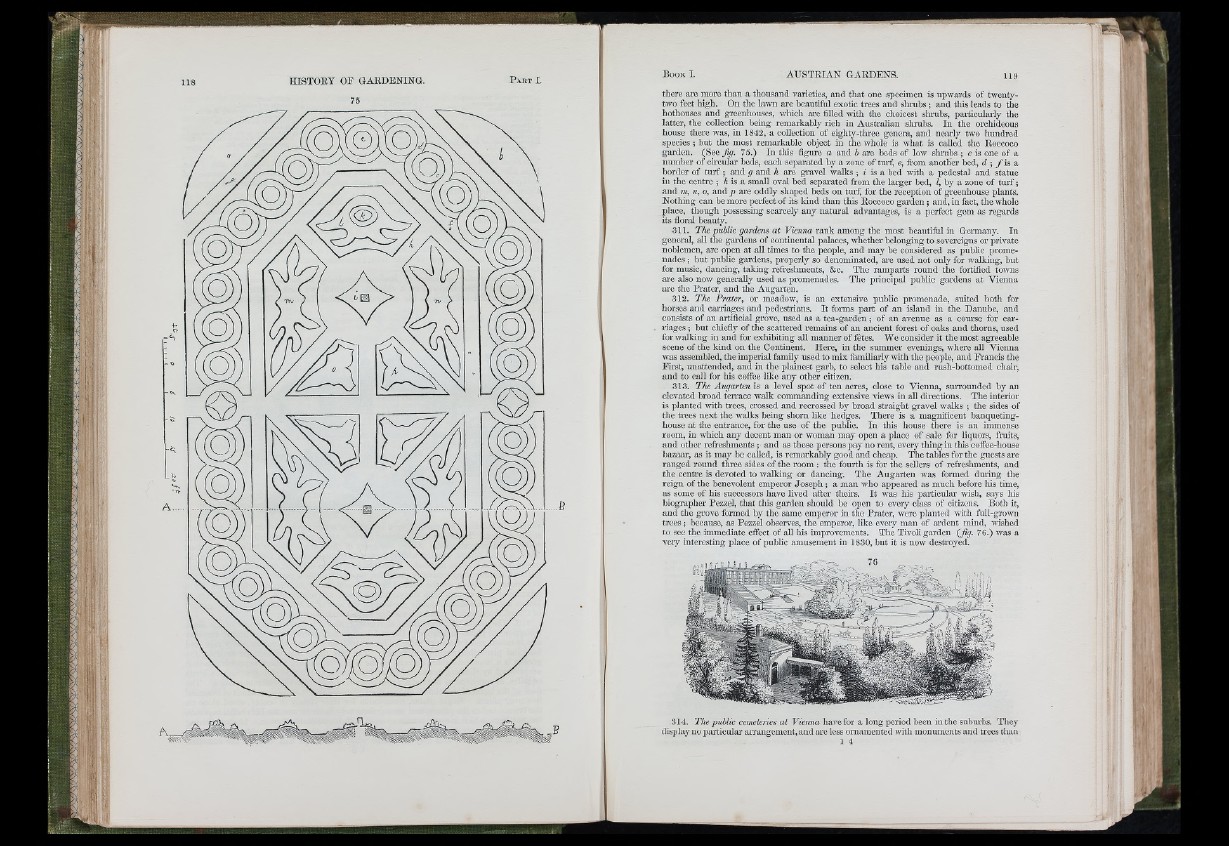
r i
B ' l j
■%
■I I
II 1 .
tliere arc more than a thousand varieties, and that one specimen is upwards of twenty-
two feet high. On the lawn are beautiful exotic trees and shrabs ; and tliis leads to the
hothouses and gi-eenhouscs, which are filled with the choicest shrubs, particularly the
latter, the collection being remarkably rich in Australian slmibs. In the orchideous
house there ivas, in 1842, a collection of cighty-tlirec genera, and nearly two hundred
species ; but the most remarkable object in the whole is Avhat is called the Roccoco
gai'den. (See f g . 75.) In this figure a and b arc beds of loiv shrabs ; c is one of a
number of circular beds, each separated hy a zone of turf, e, fi-om another bed, c/ ; / i s a
border of tui-f ; and g and h ai-e gravel walks ; i is a bed with a pedestal and statue
ill the centre ; /e is a small oval bed separated from the larger bed, I, by a zone of tu rf ;
and m, n, o, and p ai-e oddly shaped beds on turf, for the reception of greenhouse plants.
Nothing can be more perfect of its kind than this Roccoco garden ; and, in fact, the whole
place, though possessing scarcely any natural advantages, is a perfect gem as regards
its floral beauty.
311. The public gardens at Ffenna rank among the most beautiful in Germany. In
general, all the gardens of continental palaces, whether belonging to sovereigns or private
noblemen, are open at all times to the people, and may be considered as public promenades
; but public gardens, properly so denominated, ai-e used not only for Avalking, but
for music, dancing, taking refreshments, &c. The rampai-ts round the fortified towns
are also now generally used as promenades. The principal public gardens at Vienna
are the Prater, and the Augarten.
312. The Prater, or meadow, is an extensive public promenade, suited both for
horses and caii-iages aud pedestrians. I t forms part of an island in the Danube, and
consists of an artificial grove, used as a tea-garden ; of an avenue as a course for carriages
; but chiefly of the scattered remains of an ancient forest of oaks and thorns, used
for walking in and for exhibiting all manner of fêtes. We consider it the most agi-eeable
scene of the kind on the Continent. Here, in the summer evenings, where all Vienna
was assembled, the imperial family used to m ix familiarly with the people, and Fi'ancis the
First, unattended, and in the plainest garb, to select his table and rush-bottomed chair,
and to call for Ms coffee like any other citizen,
313. The Augarten is a level spot of ten acres, close to Vienna, surrounded by an
elevated broad terrace walk commanding extensive views in all directions. The interior
is planted with ti-ees, crossed and recrossed by broad straight gravel walks ; the sides of
the trees next the walks being shorn hke hedges. There is a magnificent banqueting-
house at the entrance, for the use of the public. In tMs house there is an immense
room, in which any decent man or woman may open a place of sale for liquors, fi-uits,
and other refreslunents ; and as these persons pay no rent, every thing in tMs coffee-house
bazaai-, as it may be called, is remarkably good and cheap. The tables for tlie guests are
ranged round three sides of the room : the fourth is for the sellers of refreslunents, and
the centre is devoted to walking or dancing. The Augarten was foi-med during the
reign of the benevolent emperor Joseph ; a man who appeared as much before Ms time,
as some of his successors have lived after theii's. I t was Ms particular wish, says his
biogi-apher Pezzel, that this gai'den should be open to every class of citizens. Both it,
and the grove formed by the same emperor in the Prater, ivere planted with full-grown
trees ; because, as Pezzel obsci-ves, the emperor, like evei-y man of ai'dent mind, wished
to see the immediate effect of all his improvements. The Tivoli garden ( fg . 76.) was a
very interesting place of public amusement in 1830, but it is now destroyed.
314. The public cemeteries at F?cana have for a long period been in the suburbs. They
display no particular ai-rangement, and are less ornamented with monuments and trees than
I 4